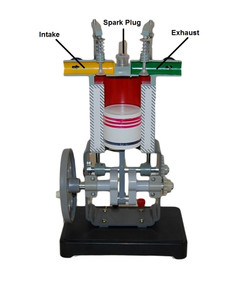This model visually demonstrates how a 4 stroke diesel engine operates. The user turns a hand crank, which in turn operates a piston. 2 different lights help to visually display what is happening at the various stages of piston travel (air intake, compression, fuel injection/combustion and exhaust). Requires two AA batteries (not included). Helps students better understand the four steps required to produce power.
The first step is the intake stroke. In a diesel engine, the intake stroke draws in air only.
The second step is the compression stroke, where the piston travels upward and compresses the air in the cylinder. A term commonly associated with this stroke is the compression ratio, which is the ratio of the volume of the cylinder chamber at the end of intake stroke (the engine has just sucked in the air) versus the volume of the cylinder chamber at the end of the compression stroke (all that air has been compressed into the top end of the cylinder). Compression raises both the pressure and temperature of the air in the cylinder chamber. In a diesel engine, the amount of compression (ratio) must be much higher than in a gasoline engine. This is because the compression actually ignites the diesel fuel.
The third step is the power stroke. The diesel fuel is sprayed into the very hot compressed air in the chamber. The hot air auto ignites the diesel fuel which then explodes and drives the piston down just like in the gas engine. This transmits power into the crankshaft which in turn drives the wheels of the truck and the other pistons through their other strokes.
The fourth and final step is the exhaust stroke. The exhaust valve opens and the piston pushes the spent combustion gases out of the cylinder chamber and into the exhaust system.
DON'T FORGET TO PURCHASE AN AIR COMPRESSION IGNITOR (A link is found below) TO DEMONSTRATE THE HIGH COMPRESSION RATIOS FOUND IN DIESEL ENGINES!
Dimensions:
Overall Height: 11.5 Inches / 290mm
Base Dimensions (lxw): 7.5 Inches x 5 Inches / 190mm x 125mm
